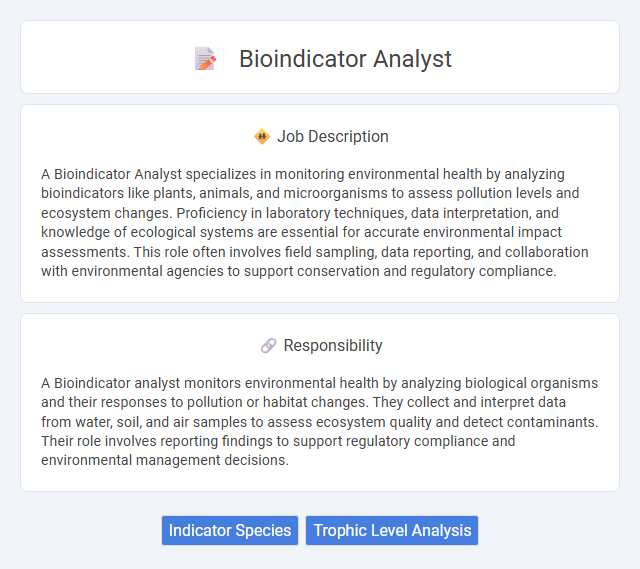
A Bioindicator Analyst specializes in monitoring environmental health by analyzing bioindicators like plants, animals, and microorganisms to assess pollution levels and ecosystem changes. Proficiency in laboratory techniques, data interpretation, and knowledge of ecological systems are essential for accurate environmental impact assessments. This role often involves field sampling, data reporting, and collaboration with environmental agencies to support conservation and regulatory compliance.
Individuals with strong attention to detail and a passion for environmental science are likely suitable for a Bioindicator Analyst role. Those comfortable with fieldwork and data analysis in varying conditions might find this job aligns with their skills and interests. People who prefer routine, indoor-only tasks may have a lower probability of thriving in this dynamic and investigative position.
Qualification
A Bioindicator Analyst must possess a strong background in environmental science, biology, or ecology, typically requiring a bachelor's or master's degree in these fields. Proficiency in identifying and monitoring bioindicator species, as well as skills in data collection, statistical analysis, and interpretation of ecological health indicators, is essential. Experience with environmental sampling techniques, knowledge of regulatory standards, and familiarity with geographic information systems (GIS) enhance the analyst's capability to assess ecosystem conditions effectively.
Responsibility
A Bioindicator analyst monitors environmental health by analyzing biological organisms and their responses to pollution or habitat changes. They collect and interpret data from water, soil, and air samples to assess ecosystem quality and detect contaminants. Their role involves reporting findings to support regulatory compliance and environmental management decisions.
Benefit
A Bioindicator Analyst likely provides critical insights into environmental health by interpreting biological data to assess ecosystem conditions, which can lead to improved regulatory compliance and conservation strategies. The role probably offers opportunities for professional growth through specialization in environmental science and exposure to cutting-edge bioassessment technologies. Job benefits might include a meaningful impact on public health and natural resource management, combined with potential competitive salaries and job stability in the growing field of environmental monitoring.
Challenge
Bioindicator analyst roles likely involve complex challenges such as accurately interpreting ecological data to assess environmental health. Professionals probably face obstacles in distinguishing subtle variations in bioindicator species that signal ecological changes. Managing large datasets and staying updated with evolving environmental regulations may also present ongoing difficulties in this field.
Career Advancement
Bioindicator analysts monitor environmental health by assessing biological markers in ecosystems, providing critical data for regulatory compliance and conservation efforts. Expertise in data analysis, ecological assessment, and laboratory techniques enhances opportunities for promotion to senior analyst or environmental consulting roles. Continuous skill development in geographic information systems (GIS) and environmental regulations drives career growth in government agencies and private sector firms.
Key Terms
Indicator Species
Bioindicator analysts specialize in assessing environmental health by studying indicator species known for their sensitivity to habitat changes. These species provide critical data on ecosystem quality, pollution levels, and biodiversity shifts, enabling precise environmental monitoring. Proficiency in species identification, data analysis, and ecological impact assessment is essential for effective bioindicator evaluations.
Trophic Level Analysis
Bioindicator analysts specializing in trophic level analysis assess ecosystem health by examining organisms at various positions within food webs. Utilizing stable isotope analysis and biomarker data, they infer feeding relationships and energy flow dynamics to monitor environmental changes and pollutant impacts. Accurate trophic level assessments support biodiversity conservation and resource management strategies by identifying shifts in ecological balance.
 kuljobs.com
kuljobs.com